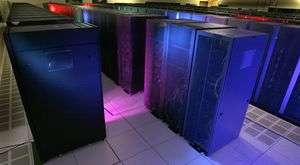End of the line for Roadrunner supercomputer

It's the end of the line for Roadrunner, a first-of-its-kind collection of processors that once reigned as the world's fastest supercomputer. The $121 million supercomputer, housed at one of the premier U.S. nuclear weapons research laboratories in northern New Mexico, will be decommissioned Sunday.
The reason? The world of supercomputing is evolving and Roadrunner has been replaced with something smaller, faster, more energy efficient and cheaper. Still, officials at Los Alamos National Laboratory say it's among the 25 fastest supercomputers in the world.
"Roadrunner got everyone thinking in new ways about how to build and use a supercomputer," said Gary Grider, who works in the lab's high performance computing division. "Specialized processors are being included in new ways on new systems and being used in novel ways. Our demonstration with Roadrunner caused everyone to pay attention."
In 2008, Roadrunner was first to break the elusive petaflop barrier by processing just over a quadrillion mathematical calculations per second.
Los Alamos teamed up with IBM to build Roadrunner from commercially available parts. They ended up with 278 refrigerator-size racks filled with two different types of processors, all linked together by 55 miles (89 kilometers) of fiber optic cable. It took nearly two dozen tractor trailer trucks to deliver the supercomputer from New York to northern New Mexico.
The supercomputer has been used over the last five years to model viruses and unseen parts of the universe, to better understand lasers and for nuclear weapons work. That includes simulations aimed at ensuring the safety and reliability of the aging U.S. arsenal.
As part of the U.S. nuclear stockpile stewardship program, researchers used Roadrunner's high-speed calculation capabilities to unravel some of the mysteries of energy flow in weapons.
Los Alamos has been helping pioneer novel computer systems for decades. In 1976, the lab helped with the development of the Cray-1. In 1993, the lab held the fastest supercomputer title with the Thinking Machine CM-5.
"And to think of where we're going to be in the next 10 to 15 years, it's just mindboggling," said lab spokesman Kevin Roark.
Right now, Los Alamos—along with scientists at Sandia National Laboratories in Albuquerque and Lawrence Livermore National Laboratory in California—is using a supercomputer dubbed Cielo. Installed in 2010, it's slightly faster than Roadrunner, takes up less space and came in at just under $54 million.
Roark said in the next 10 to 20 years, it's expected that the world's supercomputers will be capable of breaking the exascale barrier, or one quintillion calculations per second.
There will be no ceremony when Roadrunner is switched off Sunday, but lab officials said researchers will spend the next month experimenting with its operating system and techniques for compressing memory before dismantling begins. They say the work could help guide the design of future supercomputers.
Copyright 2013 The Associated Press. All rights reserved. This material may not be published, broadcast, rewritten or redistributed.

















